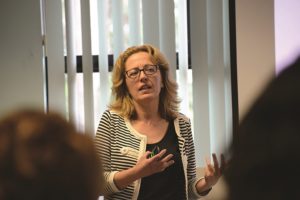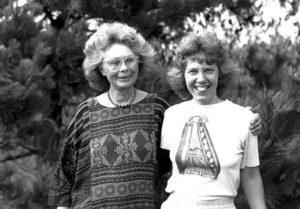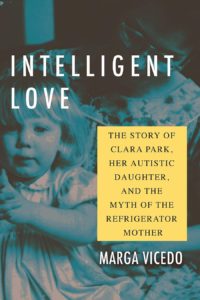Teaching English to G.I.s returning to peacetime America after World War II, Clara Park wrote her mother of her frustration with Henry David Thoreau’s Walden. Her students, she noted, “had not fought a war and come back to read some prick from Harvard who tells them that a house is just a burden and that they can live on beans and so forth.”
Historian of science Marga Vicedo foregrounds such examples of Park’s wit, compassion, and pragmatism in Intelligent Love: The Story of Clara Park, Her Autistic Daughter, and the Myth of the Refrigerator Mother, published in March by Beacon Press. This fascinating book situates readers in a particularly harrowing moment in American cultural history, when scientific authorities and therapists blamed mothers for children’s behaviors that are now understood to be based in biology, not environment.

Park gave birth in 1958 to her fourth child, a daughter she and her husband named Jessica. Called “Jessy,” this child was markedly different from her older siblings. She was slow to reach developmental milestones, had little interest in engaging with others, and did not imitate or use spoken language in conventional ways. Though Park and her husband sought help from doctors, they received little practical support or encouragement. Park had begun taking extensive notes to document Jessy’s behaviors, but this, along with her education, only suggested to medical professionals that she was a cold intellectual — a “refrigerator mother” — who deprived her child of maternal affection. They didn’t see her as a woman with formidable powers of observation and communication.
Park turned her notes into newsletters and, eventually, books. In 1967, she published The Siege: The First Eight Years of an Autistic Child, a challenge to the standard view that parents, especially mothers, were to blame for symptoms associated with autism. In 2001, Park followed The Siege with Exiting Nirvana: A Daughter’s Life With Autism, a profound and pathbreaking presentation of Jessy’s transit from childhood to young adulthood. Park’s writings inspired other parents to work together to identify effective treatments and interventions for their children. Delving into archives of Park’s letters and Jessy’s medical records, Vicedo explains how and why Park came to write both books. She also examines the effect of these books on the creation of support networks for parents and for people with autism.

A professor at the University of Toronto who studies the intersections of gender, genetics, and child development, Vicedo is well positioned to write Park’s biography and also to present a detailed history of autism as a diagnosis. She explains why doctors were convinced that what we now accept as autism (a neurobiological difference present at birth) was either a manifestation of adult psychiatric disorders, particularly schizophrenia, or a syndrome brought on by maternal neglect. The second of her eight chapters focuses on scientists and therapists debating such theories and diagnoses, including Hans Asperger, Georg Frankl, Sigmund Freud, Leo Kanner, Bruno Bettelheim, Erik Erikson, and John Bowlby. General readers may be put off by Vicedo’s attention to the twists and turns of diagnostic battles. They may also find her reliance on the scholarly “we” — as in “as we have seen” — off-putting and didactic.
But readers will find Intelligent Love riveting when Vicedo explains how one parent activist encouraged the creation of a research community based in science and how she worked to advance the belief that parents — especially smart, loving mothers — were critically important contributors to a growing understanding of autism. Park advocated for a “systematic, loving approach, using creative play” to help children with autism learn. “Couldn’t a mother use her mind as well as her heart in raising her child?” Vicedo asks. “It was true that Jessy’s development had become a project for Clara. But did that make her a bad mother? Would it have been better for Jessy if her mother had simply loved her ‘instinctively’ but did not use her powerful intelligence to understand her needs and develop effective strategies to help her grow?”

Vicedo is also very good at contextualizing beliefs and practices now considered outmoded and even inhumane. For example, she describes the effect of Ole Ivar Lovaas’s “applied behavioral therapy,” the precursor of applied behavior analysis, or ABA. Vicedo explains that Lovaas rejected the concept of autism as a “mental disease,” treating it instead as a developmental condition present at birth — a sea change at the time. Lovaas’s approach used rewards such as sweets, sips of juice, and affection to teach behaviors most autistic children find difficult to learn. But Lovaas’s version of ABA also sanctioned “aversives,” including electric shocks, to prevent self-harm. Vicedo explains that many parents didn’t want to punish their children. Autistic people also objected to being trained not to engage in behaviors such as hand flapping or rocking that don’t actually harm anyone.
Vicedo brings what could be an esoteric debate back to Park, who was willing to use what she considered helpful in parenting Jessy and rejected the rest. She focused on the positive and the possible. Rather than describing Jessy as having “obsessions,” Park preferred “enthusiasms.” She respected Jessy’s creation of analogies and number systems, especially when they were so complicated that it took the likes of physicist Freeman Dyson, a family friend, to uncover the underlying logic. Vicedo does a wonderful job showing Park’s appreciation of her atypical daughter’s own heart and mind. Jessy became a mail clerk at Williams College and a celebrated painter, and remains so to this day.
Vicedo acknowledges that Intelligent Love is neither a full history of Park nor of autism. By bringing the two together, meanwhile, she has given readers a splendid opportunity to appreciate just how hard many have worked to reach what she describes as a “greater acceptance of the diversity of human bodies, minds, and behaviors.”



